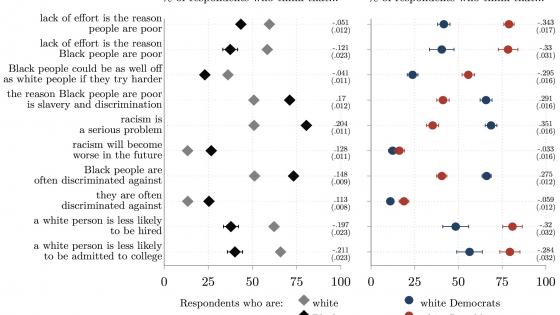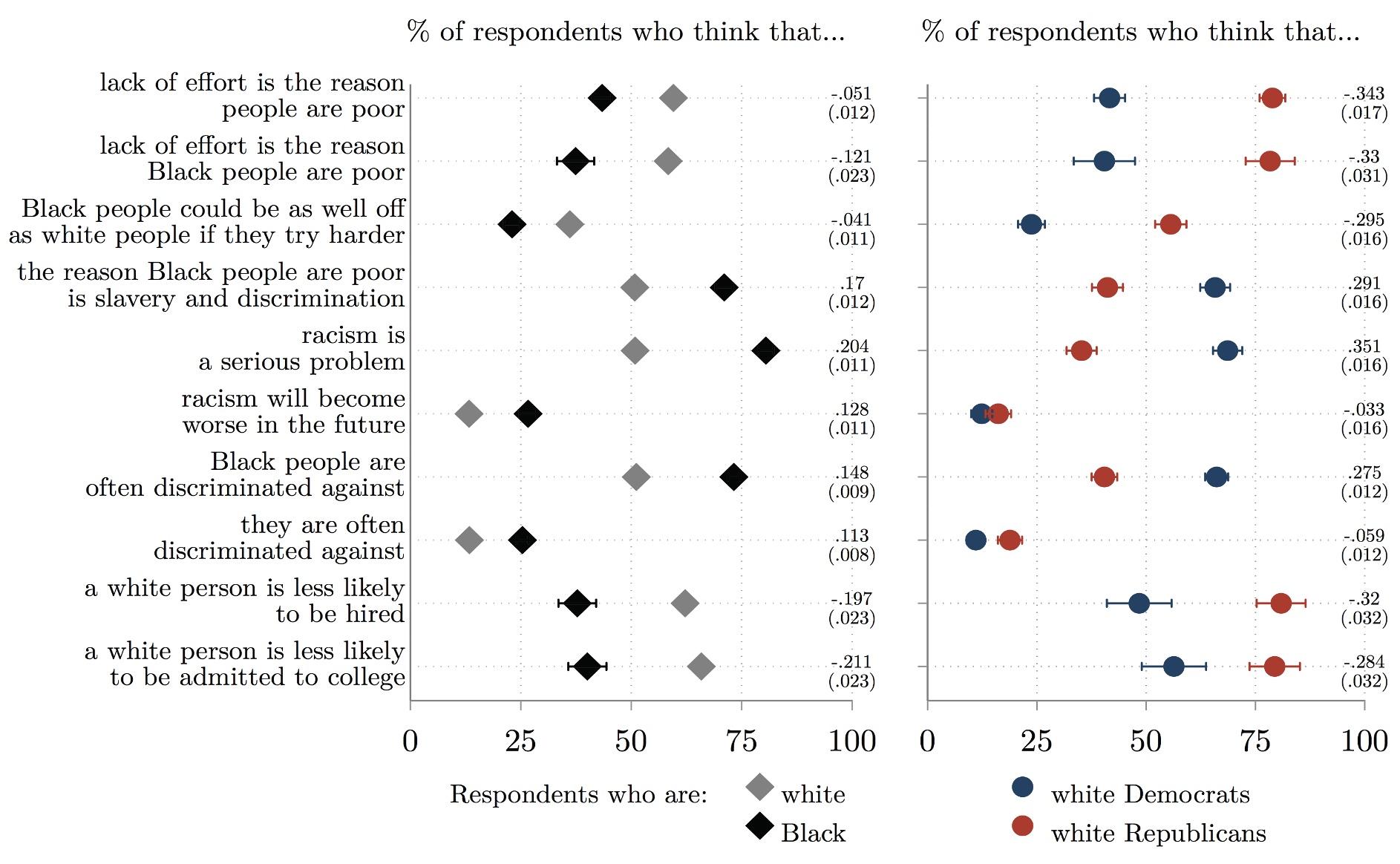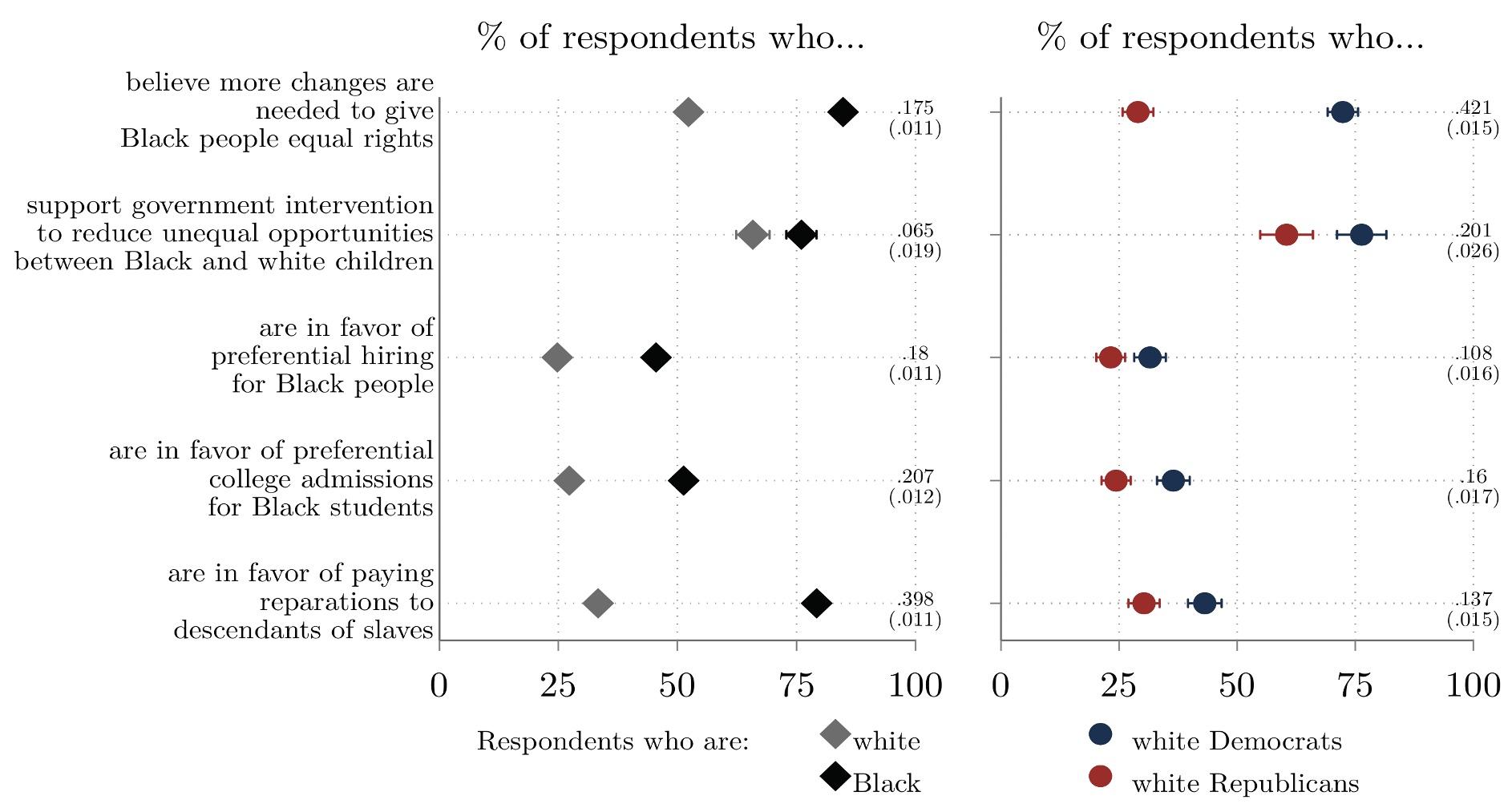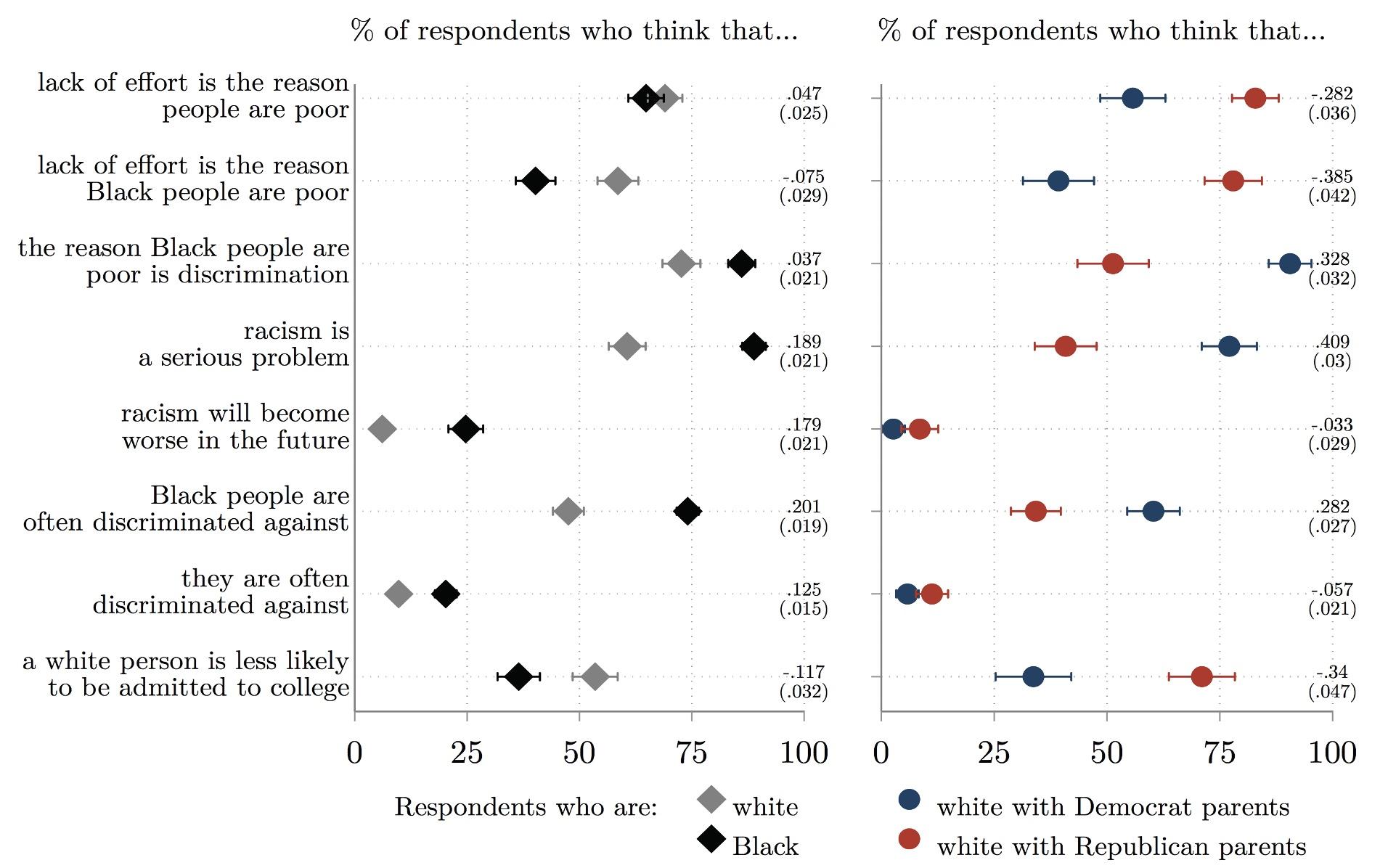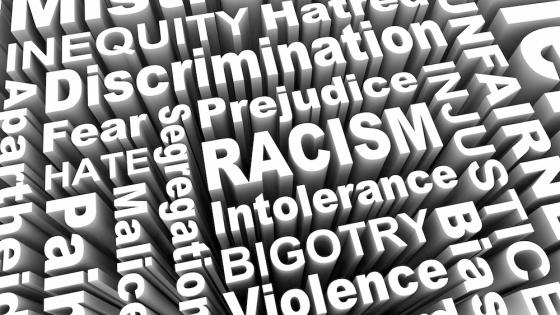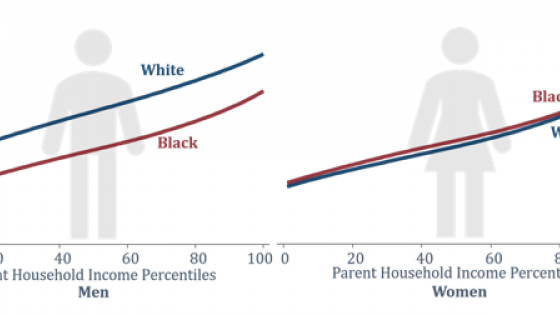Median Black household income in the US is approximately 60% of the median white household income, and the share of Black Americans who live below the poverty line is more than twice that of white Americans (Pew Research Center 2016). A Black man’s life expectancy is on average 4.5 years shorter than that of a white man; a Black woman’s life expectancy is three years shorter than that of a white woman. While the rate of Black home ownership rose in the decades from 1940 to 1970, it remains just above half the rate of white home ownership today (Boustan and Margo 2011).
The murder of George Floyd brought the condition of African Americans back to the forefront of public debate. Furthermore, racial gaps may have been exacerbated by the COVID-19 pandemic (Bertocchi and Dimico 2020). While the boosted attention to racial gaps is recent, the gaps themselves are by no means recent or unexposed. Nonetheless, little agreement exists on the sources of these problems or what should be done to address them.
Are most people simply unaware of the disparate opportunities and outcomes between Black and white Americans? Or do people see the same reality but explain its existence differently? Perhaps people disagree on whether anything should be done at all, as implied by the long-standing undercurrent of racial attitudes in shaping support for redistribution (Gilens 1995, 1996). Or is it that people agree that policy action is needed, but disagree on whether to prioritise broad, income-targeted redistribution or race-targeted interventions?
Researchers from various fields have tried to answer to these questions. Previous studies suggest, for example, that opposition to race-targeted policies is rooted in a mix of self-interest, stratification beliefs, and racial prejudice (Bobo and Kluegel 1993, Bobo and Johnson 2000); moreover, gaps in perceived discrimination correlate with support for these policies (Kluegel and Bobo 2001). Other studies have focused on perceptions, indicating that people tend to overestimate Black people’s economic circumstances (Kraus et al. 2017) and mobility (Davidai and Walker 2021).
In a recent project (Alesina et al. 2021), we study what a large sample of Black and white Americans know about racial inequities, what they believe causes them, and what, if anything, they think should be done to reduce them. We are interested in documenting perceptions about racial gaps along many dimensions, focusing on respondents’ views about the circumstances and opportunities of their own racial group and those of others. Considering both race-targeted and income-targeted redistribution policies to reduce racial gaps, we investigate whether differences in policy views lie in people’s perceptions of racial inequities or rather in their beliefs about what causes them. Finally, we want to understand whether these views form early in life, specifically during the teenage years.
To do so, we use new large-scale survey and experimental data that cover many cities in the US, and survey both adults and adolescents, aged 13 to 17. Our sample contains 50% Black respondents and 50% white respondents.
Main findings
We find significant racial and partisan gaps in perceptions of the economic conditions and opportunities of Black and white Americans. The most notable disagreements lie with perceived causes of racial inequities (see Figure 1) and, subsequently, what should be done to remedy them (see Figure 2). Furthermore, the perceptions and attitudes of the average white respondent obscure a large heterogeneity by political affiliation. Along many dimensions, for example, white Democratic respondents are more aligned with Black Democratic respondents than with white Republicans. Black and white Democratic respondents are much more likely to attribute persistent racial gaps to slavery, long-standing discrimination, and racism, and to want to reduce them through income-targeted redistribution and race-targeted policies. In contrast, white Republican respondents tend to view racial inequities primarily as the result of lack of effort or individual decisions, and to support less intervention to reduce them.1
Figure 1 Perceived causes of racial gaps: Adult survey2
Figure 2 Views on race-targeted policies: Adult survey
Teenagers
Psychologists consider childhood and adolescence to be “highly impressionable years” (Krosnick and Alwin 1989) – that is, a period in which individuals form durable beliefs and attitudes. Accordingly, we studied teenagers’ perceptions and attitudes as well. These racial and partisan gaps are already notably prevalent among teenagers, whose views imply substantial partisan gaps in line with their parents’ political affiliation. In fact, their views are even more polarised across political lines than those of their parents.
Furthermore, when it comes to the perceived causes of racial gaps (see Figure 3), white teenagers from Democratic families are much more aligned with Black teenagers from Democratic families than they are with white teenagers from Republican families – similar to the patterns seen among adults. Overall, it appears that parents’ beliefs about individual responsibility, the role of effort, and race, which are at the core of the partisan divide, have already been absorbed – even amplified – by their teen children.
The patterns on race-targeted policy views (see Figure 4) are similar in the youth survey; however, they are even more polarised by political affiliation insofar as teenagers in Republican families are more opposed to many race-targeted policies than their parents. There are apparent differences by race, too. Most notably, Black and white teenagers are divided in their support for reparations. Furthermore, white teenagers are more strongly opposed than white adults to preferential college admissions, perhaps because their age group stands to be more directly affected by this issue.
Figure 3 Perceived causes of racial gaps: Youth survey3
Figure 4 Views on race-targeted policies: Youth survey
Role of exposure to racial gaps
Previous studies have indicated how high levels of segregation (Cutler and Glaeser 1997) and neighbourhood characteristics such as high poverty levels and significant racial bias (Chetty et al. 2020) negatively affect the social and economic conditions of Black people. Thanks to our fine-grained location data at the ZIP code level for respondents, we were able to match their individual-level perceptions, views, and attitudes to the characteristics of their area of residence. We find that, for white adult respondents, exposure to more Black people and larger racial gaps in their postcode correlates strongly with the attribution of racial disparities to adverse circumstances, slavery, racism, and discrimination – and with a preference for policies aimed at closing racial gaps.
Policy views
Are the differences regarding these race-targeted and income-targeted redistribution policies rooted in people’s perceptions of racial inequities, or rather in their beliefs of what causes them? To investigate these questions, we decompose policy views into underlying factors that shape them. We find that it is not the perceived magnitudes of racial gaps, but rather their perceived causes that have the highest predictive power. In fact, support for race-targeted policies is strongly correlated with the belief that past and present discrimination and racism are to blame. By contrast, support for general redistribution is positively correlated with perceptions of racism and discrimination today. It is less associated with perceived past slavery and discrimination, and negatively correlated with the belief that Black people are poor because of lack of effort rather than due to adverse circumstances. When we consider the partisan and racial gaps in policy views, we find that the divergences lie in what people believe causes racial inequities, not in the magnitudes of those inequities, which is in line with the previous result.
In the experimental part of the study, we investigate the causal impact that information on racial inequities and explanations for these inequities has on respondents’ views. When we show information on the evolution of the Black-white earnings gap or the differences in mobility for Black and white children, respondents adjust their perceptions on these dimensions; but their policy views are not affected. On the contrary, explaining some of the causes – such as red-lining and subsequent residential segregation, along with the consequences of systemic racism – makes respondents more supportive of race-targeted and redistribution policies. Nonetheless, beliefs about the causes of racial inequities are entrenched and difficult to move for some respondents. Thus, while such treatment makes white Democrats support more policies to help close racial gaps, it has much weaker effects on white Republicans, and sometimes the effects are in the opposite direction, decreasing their support. The consequences of the treatment on white right-wing respondents appear to be partially driven by those who consider it to be left-wing biased, a perception that is itself endogenous to their prior views.
These results suggest that simply showing the degree to which circumstances and opportunities are unequal does not move people’s prior beliefs about why they are unequal. Such information on racial gaps does not change the narrative that respondents have in mind and, as a consequence, will not affect their policy views.
On a tiny scale, this mirrors the real world: although there are clearly large racial gaps along many economic and social dimensions, and although many people are – at least to some extent – aware of those gaps, they disagree on their causes. Consequently, they disagree about how to reduce them and even whether or not the need for such reduction exists.
Concluding remarks
This study demonstrated that while people have disparate perceptions concerning the magnitudes of racial gaps in economic conditions and opportunities, the biggest divergences lie with their explanations for the existence of such gaps. Furthermore, the responses of an average white respondent obscure substantial heterogeneity by political affiliation. Strikingly, racial and partisan gaps in views and attitudes are already well-established among teenagers, in line with their parents’ race and political affiliation.
People’s beliefs about how racial gaps can be explained are also more predictive of their policy views than their perceptions of the prevalence or magnitude of racial inequities. However, beliefs about the causes of racial gaps are entrenched, even among teenagers, and not easy to shift. Clearly, the extent to which respondents are exposed to racial inequities, either directly or indirectly, varies tremendously. The causes of racial gaps may be even harder for people to observe or see directly. People’s views are thus likely to depend on their own knowledge, sources of news, longstanding narratives, and racial attitudes. Many of these factors vary by political affiliation, as well as by race. Therefore, since the beliefs that are simultaneously the most polarised and the most predictive of policy views are also the hardest to move, it is unlikely that we will see bipartisan agreement as to how to address these racial gaps anytime soon.
References
Alesina, A, M F Ferroni and S Stantcheva (2021), “Perceptions of Racial Gaps, their Causes, and Ways to Reduce Them”, NBER Working Paper 29245.
Bertocchi, G and A Dimico (2020), “Race and the COVID-19 pandemic”, VoxEU.org, 29 July.
Boustan, L and R Margo (2011), “White suburbanisation facilitated black homeownership in the mid-20th century”, VoxEU.org, 12 February.
Bobo, L and D Johnson (2000), “Racial attitudes in a prismatic metropolis: Mapping identity, stereotypes, competition, and views on affirmative action”, Prismatic Metropolis: Inequality in Los Angeles, Russell Sage Foundation, 81–164.
Bobo, L and J R Kluegel (1993), “Opposition to race-targeting: Self-Interest, stratification ideology, or racial attitudes?”, American Sociological Review 58(4): 443–464.
Chetty, R, N Hendren, M R Jones and S Porter (2020), “Race and Economic Opportunity in the United States: An Intergenerational Perspective”, Quarterly Journal of Economics 135(2): 711–783.
Cutler, D M and E L Glaeser (1997), “Are ghettos good or bad?”, The Quarterly Journal of Economics 112(3): 827–872.
Davidai S and J Walker (2021), “Americans Misperceive Racial Disparities in Economic Mobility”, Journal of Patient Experience, 24–32.
Gilens, M (1995), “Racial attitudes and opposition to welfare”, The Journal of Politics 57(4): 994–1014.
Gilens, M (1996), “‘Race Coding’ and white opposition to welfare”, The American Political Science Review 90(3): 593–604.
Kluegel, J R and L D Bobo (2001), “Perceived group discrimination and policy attitudes: The sources and consequences of the race and gender gaps”, Urban Inequality: Evidence from Four Cities, Russell Sage Foundation, 163–214.
Kraus, M W, J M Rucker and J A Richeson (2017), “Americans misperceive racial economic equality”, Proceedings of the National Academy of Sciences 114 (39): 10324–10331.
Krosnick, J A and D F Alwin (1989), “Aging and susceptibility to attitude change”, Journal of Personality and Social Psychology 57(3): 416–425.
Logan, T and J Parman (2015), “The rise of residential segregation”, VoxEU.org, 09 March.
Pew Research Center (2016), “On Views of Race and Inequality, Blacks and Whites are Worlds Apart”, 27 June.
Endnotes
1 Our results hold similarly if we split the sample into voters who supported Trump or Clinton in 2016, a classification that has the advantage of also including those who consider themselves Independents.
2 Data collected between April and July 2019 and in June 2020.
3 Data collected between May and June 2020.
